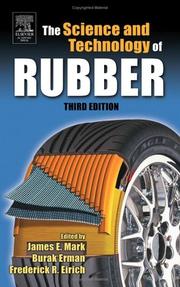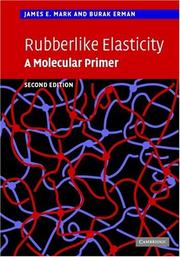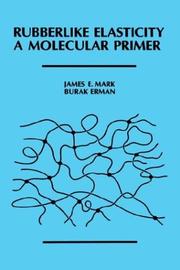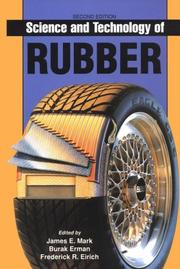| Listing 1 - 8 of 8 |
Sort by
|

ISBN: 1280628642 9786610628643 0080456014 0124647863 9780080456010 9780124647862 Year: 2005 Publisher: Amsterdam ; Boston : Elsevier Academic Press,
Abstract | Keywords | Export | Availability | Bookmark
 Loading...
Loading...Choose an application
- Reference Manager
- EndNote
- RefWorks (Direct export to RefWorks)
The 3rd edition of The Science and Technology of Rubber provides a broad survey of elastomers with special emphasis on materials with a rubber-like elasticity. As in the 2nd edition, the emphasis remains on a unified treatment of the material; exploring topics from the chemical aspects such as elastomer synthesis and curing, through recent theoretical developments and characterization of equilibrium and dynamic properties, to the final applications of rubber, including tire engineering and manufacturing. Many advances have been made in polymer and elastomers research over the past te
Rubber. --- Caoutchouc --- Ebonite --- Gum elastic --- India rubber --- Vulcanite --- Latex --- Non-timber forest products --- Elastomers --- Gutta-percha --- Chemistry --- Polymers and Plastics

ISBN: 0197560431 1280526807 9786610526802 0195359607 1429414510 9781429414517 9780195082371 0195082370 9780197560433 Year: 1997 Publisher: New York : Oxford University Press,
Abstract | Keywords | Export | Availability | Bookmark
 Loading...
Loading...Choose an application
- Reference Manager
- EndNote
- RefWorks (Direct export to RefWorks)
Rubber elasticity is an important sub-field of polymer science. This book is a sequel to the authors' previous, more introductory book, Rubberlike Elasticity: A Molecular Primer (Wiley-Interscience, 1988), and will in some respects replace the now classic book by L.R.G. Reloar, The Physics of Rubber Elasticity (Oxford, 1975). The present book has much in common with its predecessor, in particular its strong emphasis on molecular concepts and theories; similarly, only equilibrium properties are covered in any detail. Though this book treats much of the same subject matter, it is a more comprehensive, more up-to-date, and somewhat more sophisticated treatment.
Polymer networks. --- Elastomers. --- Elastomeric materials --- Reinforced elastomers --- Polymers --- Plastics --- Rubber --- Interpenetrating polymer networks --- IPN (Polymers) --- Networks, Polymer --- Crosslinked polymers

ISBN: 9780511541322 9780521814256 9780511269936 0511269935 0511267304 9780511267307 0511269374 9780511269370 0511541325 1280750308 9781280750304 9786610750306 6610750300 0511268580 9780511268588 0521814251 1107159113 0511320701 0511269250 9781107159112 9780511320705 9780511269257 Year: 2007 Publisher: Cambridge New York Cambridge University Press
Abstract | Keywords | Export | Availability | Bookmark
 Loading...
Loading...Choose an application
- Reference Manager
- EndNote
- RefWorks (Direct export to RefWorks)
Elastomers and rubberlike materials form a critical component in diverse applications that range from tyres to biomimetics and are used in chemical, biomedical, mechanical and electrical engineering. This updated and expanded edition provides an elementary introduction to the physical and molecular concepts governing elastic behaviour, with a particular focus on elastomers. The coverage of fundamental principles has been greatly extended and fully revised, with analogies to more familiar systems such as gases, producing an engaging approach to these phenomena. Dedicated chapters on novel uses of elastomers, covering bioelastomers, filled elastomers and liquid crystalline elastomers, illustrate the established and emerging applications at the forefront of physical science. With a list of experiments and demonstrations, problem sets and solutions, this is a self-contained introduction to the topic for graduate students, researchers and industrialists working in the applied fields of physics and chemistry, polymer science and engineering.
Elastomers. --- Elasticity. --- Polymers. --- Polymere --- Polymeride --- Polymers and polymerization --- Macromolecules --- Elastic properties --- Young's modulus --- Mathematical physics --- Matter --- Statics --- Rheology --- Strains and stresses --- Strength of materials --- Elastomeric materials --- Reinforced elastomers --- Polymers --- Plastics --- Rubber --- Properties

ISBN: 0471614998 9780471614999 Year: 1988 Publisher: New York: Wiley,
Abstract | Keywords | Export | Availability | Bookmark
 Loading...
Loading...Choose an application
- Reference Manager
- EndNote
- RefWorks (Direct export to RefWorks)
Polymers --- Elasticity
Digital
ISBN: 9780123948328 0123948320 Year: 2013 Publisher: Amsterdam ;Boston Elsevier Academic Press
Abstract | Keywords | Export | Availability | Bookmark
 Loading...
Loading...Choose an application
- Reference Manager
- EndNote
- RefWorks (Direct export to RefWorks)
The 4th edition of The Science and Technology of Rubber provides a broad survey of elastomers with special emphasis on materials with a rubber-like elasticity. As in the 3rd edition, the emphasis remains on a unified treatment of the material; exploring topics from the chemical aspects such as elastomer synthesis and curing, through recent theoretical developments and characterization of equilibrium and dynamic properties, to the final applications of rubber, including tire engineering and manufacturing. Many advances have been made in polymer and elastomers research over the past ten years since the 3rd edition was published. Updated material stresses the continuous relationship between the ongoing research in synthesis, physics, structure, and mechanics of rubber technology and industrial applications. Special attention is paid to recent advances in rubber-like elasticity theory and new processing techniques for elastomers. This new edition is comprised of 20% new material, including a new chapter on environmental issues and tire recycling. Provides the most comprehensive survey of elastomers for engineers and researchers in a unified treatment: the text moves from the chemical aspects such as elastomer synthesis and curing, through recent theoretical developments and characterization of equilibrium and dynamic properties, to the final applications of rubber, including tire engineering and manufacturing. Contains important updates to several chapters, including elastomer synthesis, characterization, viscoelastic behavior, rheology, reinforcement, tire engineering, and recyclingIncludes a new chapter on the burgeoning field of bioelastomers.
Book
ISBN: 0123948320 0123945844 9780123948328 9780123945846 Year: 2013 Publisher: Oxford, England : Academic Press,
Abstract | Keywords | Export | Availability | Bookmark
 Loading...
Loading...Choose an application
- Reference Manager
- EndNote
- RefWorks (Direct export to RefWorks)
The 4e of The Science and Technology of Rubber provides a broad survey of elastomers with special emphasis on materials with a rubber-like elasticity. As in previous editions, the emphasis remains on a unified treatment of the material, exploring chemical aspects such as elastomer synthesis and curing, through recent theoretical developments and characterization of equilibrium and dynamic properties, to the final applications of rubber, including tire engineering and manufacturing. Updated material stresses the continuous relationship between ongoing research in synthesis, physics, stru
Rubber. --- Rubber --- Mechanical Engineering --- Engineering & Applied Sciences --- Industrial & Management Engineering --- Chemistry --- Polymers and Plastics --- Caoutchouc --- Ebonite --- Gum elastic --- India rubber --- Vulcanite --- Latex --- Non-timber forest products --- Elastomers --- Gutta-percha
Digital
ISBN: 0080456014 9780080456010 Year: 2005 Publisher: Boston Elsevier Academic Press
Abstract | Keywords | Export | Availability | Bookmark
 Loading...
Loading...Choose an application
- Reference Manager
- EndNote
- RefWorks (Direct export to RefWorks)
The 3rd edition of The Science and Technology of Rubber provides a broad survey of elastomers with special emphasis on materials with a rubber-like elasticity. As in the 2nd edition, the emphasis remains on a unified treatment of the material; exploring topics from the chemical aspects such as elastomer synthesis and curing, through recent theoretical developments and characterization of equilibrium and dynamic properties, to the final applications of rubber, including tire engineering and manufacturing. Many advances have been made in polymer and elastomers research over the past ten years since the 2nd edition was published. Updated material stresses the continuous relationship between the ongoing research in synthesis, physics, structure and mechanics of rubber technology and industrial applications. Special attention is paid to recent advances in rubber-like elasticity theory and new processing techniques for elastomers. This new edition is comprised of 20% new material, including a new chapter on environmental issues and tire recycling. Explores new applications of rubber within the tire industry, from new filler materials to green tires (a tire that has yet to undergo curing and vulcanization). 30% of the material has been revised from the previous edition with the addition of 20% new material, including a chapter on the environment. A mixture of theory, experiments, and practical procedures will offer value to students, practitioners, and research & development departments in industry.

ISBN: 0124725252 Year: 1994 Publisher: San Diego : Academic Press,
Abstract | Keywords | Export | Availability | Bookmark
 Loading...
Loading...Choose an application
- Reference Manager
- EndNote
- RefWorks (Direct export to RefWorks)
Rubber. --- Elastomers. --- Caoutchouc --- Elastomères
| Listing 1 - 8 of 8 |
Sort by
|

 Search
Search Feedback
Feedback About UniCat
About UniCat  Help
Help News
News